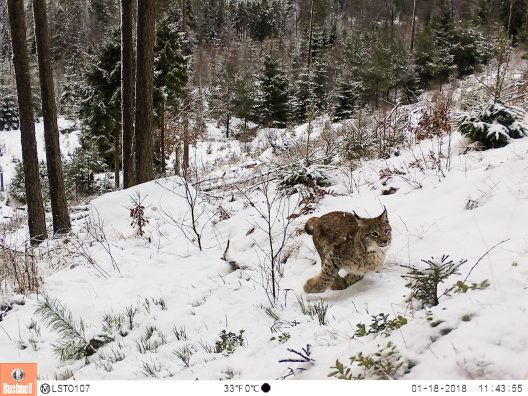New research led by SEFS Ph.D. Candidate Catherine (Katie) Breen highlights remote cameras deployed to monitor wildlife as an untapped source of snow cover observations. Published in the journal Remote Sensing of Environment last week, Breen and her advisor, Associate Professor Laura Prugh, worked with colleagues at the Norwegian Institute for Nature Research and NASA on a method combining international datasets to validate and improve satellite observations of snow cover using imagery from wildlife camera networks.

Globally, snow cover observations are used for hydrological forecasting, predicting the timing of snow melt and seasonal snow patterns, water resource planning, and animal migration patterns. Currently, satellite observations provide daily data on snow cover, but cloud and forest cover among other factors can impede the accuracy of the information.
To address this limitation and improve snow cover observations, Breen and Prugh sought to combine their respective backgrounds in remote sensing and wildlife science to explore how existing networks of wildlife cameras could supplement satellite observations to produce a more accurate picture of snow cover patterns. Colleagues in Norway working with expansive wildlife camera dataset presented an opportunity to pursue the novel concept.
“Dr. Prugh’s experience ensured expert use of camera trap datasets, and I helped bring experience with satellite datasets. Our collaborators at NASA are leaders in remote sensing for snow. The final missing piece was an extensive camera trap dataset from a highly respected Norwegian research team,” said Breen.
Breen received a NASA Graduate Fellowship and a Fellowship from the American Scandinavian Foundation and traveled to Norway to work with the Norwegian Institute for Nature Research (NINA). NINA, an applied ecological research center, hosts a network of camera traps across the country to track wildlife populations and biodiversity.
The researchers used data from over one thousand wildlife cameras, spread across 10 degrees of latitude through the forested, mountainous, and coastal regions of Norway. Along with information on wildlife habits and movement, each camera provides a trove of observations about on-the-ground snow conditions throughout the year.
Whether the observations would align with satellite imagery given the differences in scale was uncertain. While the wildlife cameras capture a field of view of about 20 to 30 meters, satellite observations are made at a scale of 500 meters, or the size of several football fields. To their surprise, the team found strong agreement between the camera trap data and satellite observations on the presence or absence of snow across the region.
“In some ways, the cameras are even more accurate because they allow you to see below the tree crowns and get some of the on-the-ground information that satellites don’t have access to,” said Breen.
However, the datasets diverge after several days of consistent cloud cover. Satellites measure snow cover based on the reflectivity of the ground surface, and in the presence of clouds, the last clear-day observation is used to predict what current conditions may be. After three or four cloudy days, the predicted value could stray significantly from true conditions on the ground as snow or rainfall may have rapidly increased or decreased the total area under snow.
Positioned beneath the cloud cover and vegetation that could hinder satellite observations, wildlife cameras provide an avenue to pinpoint sources of inaccuracies in the imagery. This research highlights the potential of remote camera networks to supplement satellite observations and create more reliable snow cover maps, particularly in regions that see heavy cloud cover throughout the winter, such as Norway and the Pacific Northwest.
As the wildlife ecology community continues to expand camera networks to monitor biodiversity, a growing opportunity exists to enhance our understanding of changing snow conditions with ground-based remote sensing data on a global scale. In a changing climate, there is an urgent need for information on the rapidly changing water availability and wildlife patterns.
The unexpected opportunity to collaborate with an ecological institute across the globe has made this research possible, said Breen. Her time with the Norwegian Institute for Nature Research allowed her to immerse herself in a new culture while completing her PhD, and even explore her own Scandinavian heritage.
“It’s exciting to draw together datasets from different research teams, different technologies, and even different fields of science, and still find they can build on one another,” said Breen.



